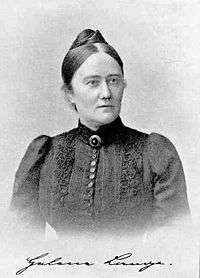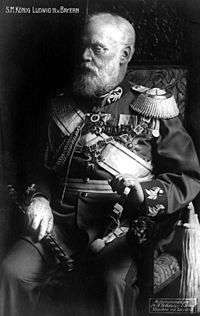Hofatelier Elvira
The Hofatelier Elvira (tr. Court atelier Elvira, also known as Atelier Elvira or Salon Elvira) was a photography studio in Munich founded by jurist and actress Anita Augspurg and friend photographer Sophia Goudstikker in 1887 and is notable as the first company founded by women in Germany. A branch also existed in Augsburg from 1891. They became especially famous for their work in the feminist movement.
_Elvira.jpg)
History

The new studio building that housed the Munich atelier at Von-der-Tann-Strasse 15, built in 1898, became a prominent structure in the style of Art Nouveau, and the façade was a design by the architect August Endell in the years from 1896 to 1898. Endell's work was influenced by Victor Horta. His plans, were licensed in April 1898 with the remark, that they were a "mockery of drawing art".[1] The façade, with its red and golden dragon-like stucco ornament on a green ground,[2] was especially criticized. The design was called "Octopus Rococo", and the building was variously called the "dragon's castle" or the "Chinese embassy".[3] The Atelier Elvira building was an artist's meeting point from the beginning. Soon after the building was completed, the founders' paths went separate ways. In 1907 Augspurg sold her share to Goudstikker, who later leased it to the young photographer Emma Uibleisen. After World War I most of the traditional clients disappeared. When Uibleisen died in 1928 there was no successor.
In the autumn of 1933, a unit from Hitler's paramilitary Sturmabteilung stationed in the building. Later when the Von-der-Tann-Strasse street was redeveloped into a main accessway to the Haus der Kunst art museum, the building was used as a provisional canteen for the construction workers. In 1937 the "dragon ornament" was removed and the building slated for demolition to make way for a planned arcade building which could not be realized during World War II. During the allied bombing campaigns in April 1944, the building became severely damaged. After the war the premises was acquired by the state of Bavaria, who ceded it to the United States for the construction of its new Consulate General of the United States, Munich.[1]
Works (selection)
Significant photographs that emerged from the atelier include:
 Feminist Helene Lange, before 1899
Feminist Helene Lange, before 1899 Author and Historian Ricarda Huch, 1901
Author and Historian Ricarda Huch, 1901
 Grand Duchess Regnant of Luxembourg Maria Anna of Portugal, 1903
Grand Duchess Regnant of Luxembourg Maria Anna of Portugal, 1903 Grand Duchess of Russia Princess Victoria Melita of Saxe-Coburg and Gotha
Grand Duchess of Russia Princess Victoria Melita of Saxe-Coburg and Gotha King Ludwig III of Bavaria, 1914
King Ludwig III of Bavaria, 1914
Bibliography
- Hof-Atelier Elvira, München (German), Munich City Museum, 1986
- Hof-Atelier Elvira, München (German), Photo Museum, 1985
- Herz, Rudolf / Bruns, Brigitte: Hof-Atelier Elvira 1887-1928. Ästheten, Emanzen, Aristokraten (German), Munich, 1985.
- August Endell: der Architekt des Photoateliers Elvira. 1871-1925 (German), exhibition catalog Stuck-Jugendstil-Verein, Munich, 1977
References
- Edgard Haider: Verlorene Pracht –- Geschichten von zerstörten Bauten. (German), Hildesheim, Gerstenberg Verlag 2006, ISBN 978-3-8067-2949-8
- Otto Kammerlohr: Epochen der Kunst (German), vol. IV, 1977, p. 45.
- Picture of the atelier building with the "dragon motif"
External links
| Wikimedia Commons has media related to Atelier Elvira. |
- Photos, Bildarchiv Foto Marburg
- Louise-Schroeder-Gymnasium
- Helene Lange Schule in Oldenburg
- Bayern Drei Online
- Hofatelier Elvira in the German National Library catalogue